One of the best team-building gifts you can give is a custom screen printed t-shirt or tote bag that displays your team name or company logo. These days, polyester costs a lot less than other fabric types like cotton, making it an affordable choice for a handmade gift! But can you screen print on polyester?
The best way to screen print on polyester is to use plastisol dye or water-based ink on top of an under-base. Choosing 100% polyester fabric rather than a blend also improves the quality of screen printing on polyester. Curing the design requires specific temperatures to avoid melting the synthetic fabric.
In this article, you will learn how screen printing works. You will find out special tips for printing on polyester. Finally, you will discover how water-based inks can impact screen printing.
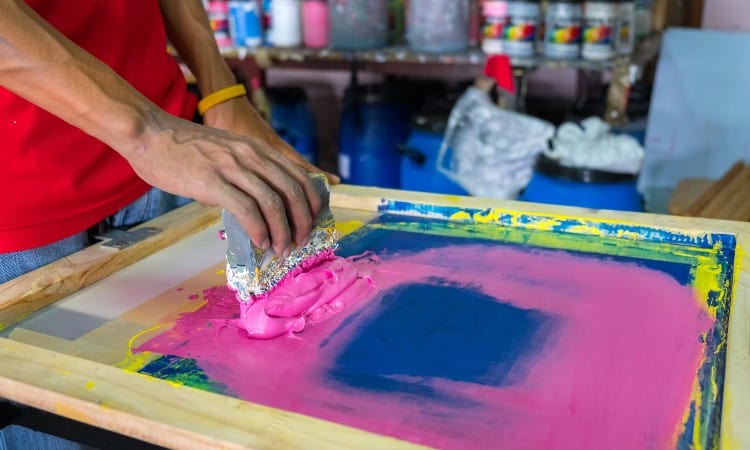
What is Screen Printing?
Screen printing transfers the negative of an image on a mesh screen to fabric. This method of printing often uses just one or two colors of thick, soft ink. More complex images can use multiple colors layered onto the fabric one at a time.
This printing method, also known as silk screening, creates a textured, raised print on fabric. It is one of the most popular methods of printing t-shirts. (The screens used in this process used to be made of silk, but today cheaper polyester mesh works just as well).
Though screenprinting does require some supplies and equipment, it allows for small batch and DIY projects far more easily than some other forms of printing. It also creates professional-looking designs when done correctly.
It takes way more time to prepare a screen print than a digital print, but it costs a lot less when you need to print large quantities of the same design.
Many commercial printers also use screenprinting rather than digital printing because the prints have better quality. Plus, screen-printed designs typically last a lot longer than digital print designs. Manufacturers or brands that want a good reputation for quality often go with screenprinting for these reasons.
Can You Screen Print on Polyester?
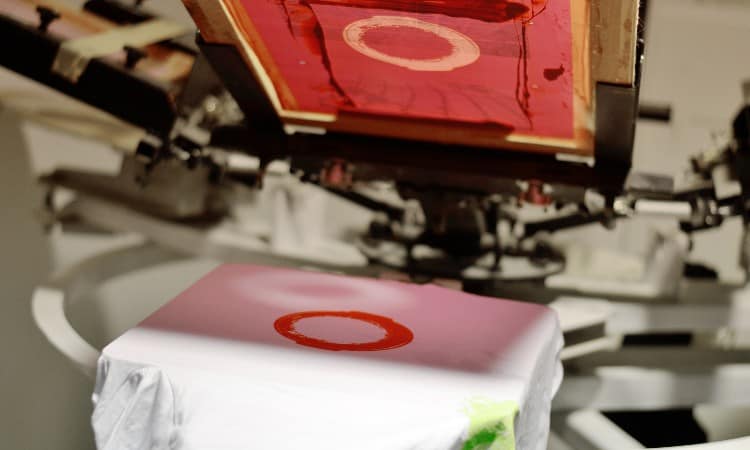
You can successfully screenprint on polyester, but you will have to use different inks and careful temperature gauging to create quality designs on synthetic material. Screenprinting on polyester presents unique challenges that you will not encounter if you choose to use 100% cotton. On the other hand, polyester costs a lot less, giving you a better overhead for your small business or a lower gift budget!
On top of that, once you master the process of screenprinting on polyester, you will no longer see all the differences between this printing style and printing on cotton. You will quickly get used to the necessary precautions used in printing on polyester!
So, while polyester is a good fabric for screenprinting, it presents a few difficulties as well. The biggest of these is called dye migration.
Dye migration happens when heat causes some of the colors in the fabric itself to leach into the ink of your printed design. Polyester comes from a fossil-fuel-based polymer and does not handle high temperatures at all well. Incorrect temperatures can also cause polyester to shrink, scorch, melt, or skew during the design-setting process.
The good news is that you can prevent these issues by using either dark ink for your design or starting with an under-base beneath the design to prevent any color from bleeding through. Of course, carefully gauging the temperature you use also helps!
You can print images on polyester using screenprinting through a method called four-color process printing. This process breaks down the colors of a photo or image into four basic shades, and each shade gets its own screen as part of the printing process. That said, screen printing often (though not always) uses simpler designs requiring fewer colors to layer on top of each other.
What is the Best Screen Printing Ink for Polyester?
 The best inks for screenprinting on polyester are plastisol ink or plastisol ink with a nylon hardener. You can find many plastisol inks designed for printing on synthetic fabric readily available online or at craft stores. You can also buy kits designed specifically for use on polyester, especially if you’re just starting!
The best inks for screenprinting on polyester are plastisol ink or plastisol ink with a nylon hardener. You can find many plastisol inks designed for printing on synthetic fabric readily available online or at craft stores. You can also buy kits designed specifically for use on polyester, especially if you’re just starting!
Water-based inks do not work as well on synthetic fabrics since these materials have hydrophobic tendencies and don’t absorb the water that carries the dye. Bright or light water-based dyes often look cracked or faded when applied to polyester. That said, you may find that you can apply water-based inks such as the Speedball brand to 100% polyester if you only use the opaque or dark colors and apply the screen quite carefully.
Screen Printing on Polyester: Step by Step
You can follow these basic steps to learn how to screenprint on polyester. Like most artistic processes, screen printing requires careful attention to detail to get a quality result.
That said, once you learn these basic steps, you will quickly feel competent to invent your own designs and tinker with your own special techniques for printing!
Materials Needed
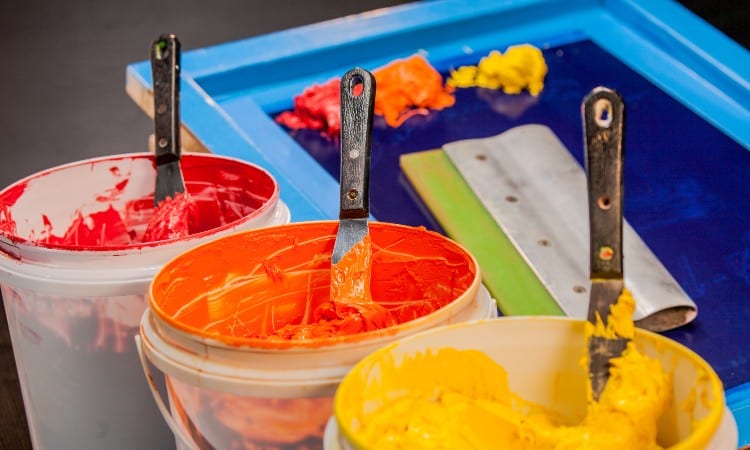
Even a small DIY screenprinting operation does require quite a few supplies, including polyester mesh screens, a printer stand, the appropriate dyes, and some kind of design program.
Check out this list to see what you need to get started with your first print!
- Screen printing frame or printer: your screenprint machine can have a simple, manual setup, or you can splurge on a $1,000, fancy automated version! If you simply like to design things and want to make handmade gifts for friends and family, you can buy a one or two-screen manual press quite cheaply. If you want to launch a small business, you probably want a high-quality automated press that can hold four to eight screens, so you can layer colors.
- Polyester mesh screens: you can purchase kits that come with premade screens. That said, you will quickly find it more cost-effective to buy yards of polyester mesh and make your screens by stretching the mesh over a wood or aluminum frame.
- Squeegee: Any flat rubber squeegee long enough to cover your screen will work. You can also find specific paper-craft squeegees or screen print squeegees. These inexpensive tools help you apply just the right amount of ink to your design!
- Painter’s tape: you need printing tape to avoid getting dye on parts of the fabric you want to keep blank. Any good-quality painter’s tape that does not leave a sticky residue on the fabric will work.
- Dyes: As you already know, dyes made to adhere to synthetic material work best. Look for dyes or inks that use the term “plastisol”. Alternatively, you can try water-based dyes if you use opaque types.
- Emulsion: if you use film positives to create your design, you will need a chemical emulsion for your screen.
- Underbase: this is a bit of a trick category because an under-base is just a layer of white or light-colored ink printed on the fabric before applying the colored design. It protects your design from dye migration by creating a buffer between the fabric and your design.
- Slip sheet or liquid adhesive: You don’t want your t-shirt or fabric item sliding all over the printer platen! These items help keep everything in place.
- Design program: You can purchase ready-made designs. If you want custom work, you can learn how to use Adobe Illustrator, PhotoShop, or even Cricut’s design program to craft your print designs. These programs also allow you to separate your colors to create your design one color layer at a time.
- Cricut stencils or film positive: These options create a stencil that allows you to paint the negative of your design onto the screen.
- Heat press, heat gun, or flash dryer: You have to take care when applying heat to polyester, but some types of dye will set better when exposed to heat. Most plastisol dyes require a heat of at least 325℉ for the dye to bond with the fibers of the polyester fabric.
Screen Printing Process
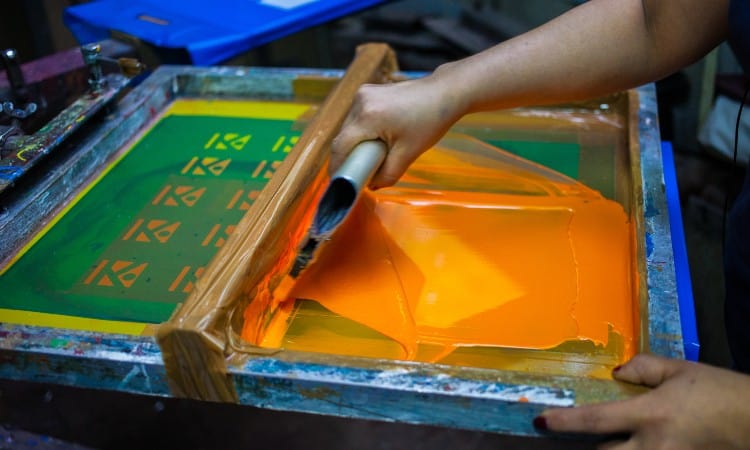
You can use either a stencil or a negative image printed on special film for your screen printing process. These basic steps will give you a clear idea of the fundamental process of each method of printing, though every project will have some unique differences.
Prep Work
Both methods require design creation and setup before you begin!
- Use design software to create the image you want to print. Getting familiar with a graphic design tool like Illustrator will allow you to create unique, custom designs!
- You can also upload a photo and use the software to separate the colors. This sounds simple, but this first step ultimately determines the quality of the whole process–make sure you use a high-quality design!
- Set up your screen by stretching polyester mesh over a frame.
Stencil Method
The simplest way to screenprint is to apply an adhesive stencil to your screen. You will want to make a stencil that fills in all the negative space around your design or lettering. This way, the ink only gets tough on the screen to fill in the design!
- Print your design onto adhesive vinyl and cut it out for simple patterns or upload your design to Cricut and use a Cricut to cut out your vinyl stencil.
- Apply the stencil to the mesh screen. You can use iron-on vinyl, adhesive vinyl, or transfer tape on plain vinyl for this.
- Tape off any remaining area of the screen around the stencil.
- Flip the screen over. You should have a backward view of your design or lettering now!
- Set up your screen in your press, or attach the top and bottom of the frame together according to the manufacturer’s directions.
- Use adhesive to set the t-shirt or fabric into place on the platen (the lower bed of the press or the bottom of the frame).
- Apply ink to the screen.
- Use a squeegee to scrape it neatly off.
- Use the mechanism on your printer to press the screen and platen together. This looks different depending on if you’re using a manual or automatic setup, so follow the directions on the device!
- Apply heat to set the dye. You will need to do this between every layer if you want to add additional colors. Make sure you follow the directions provided by the dye manufacturer to use the correct temperature.
Film Positive Method
After doing your prep work, create a unique and detailed negative of your design to apply to the mesh screen by using this method!
- After creating your design, print it out one layer at a time on sheets of film positive transparency. If you don’t have a printer that can work with film positives, you can hand-draw onto the plasticky sheets or send them to a photo printing shop.
- Coat the mesh screen with an emulsion. You need to work in a dark room for this part of the process, as light can damage the emulsion!
- Let the screen dry in the dark.
- Once dry, expose the screen to light by using an exposure light bulb. This works a lot like developing old-fashioned photos and transfers the negative of the design onto the mesh after you rinse it with water!
- Rinse the screen in cool water.
- Clamp your screen onto your press.
- Use adhesive to set the t-shirt or fabric into place on the platen.
- Apply ink to the screen.
- Use the mechanism on your printer to press the screen and platen together. This looks different depending on if you’re using a manual or automatic setup, so follow the directions on the device!
- Use a squeegee to remove excess dye and also to push the screen firmly onto the polyester.
- Apply heat to “flash” or cure the dye between each layer of color. Read the dye package and follow the directions provided by the manufacturer to use the correct temperature. Some popular forms of dyes recommend a heat of 325℉.
If that seems like many steps, remember that screenprinting involves designing your image, transferring the image to a mesh screen, and then applying the dye to the screen and fabric! It is a complex art form, but it creates beautiful results when done right.
Can You Print Images on Polyester?
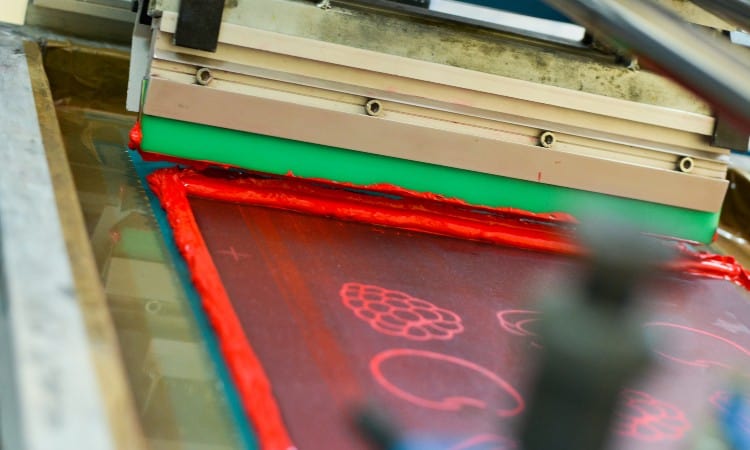
You can screen print images onto polyester by separating the colors in the design and then using a separate screen for each color as you apply the dye in layers. However, polyester does not work for direct-to-garment or DTG printing. Manufacturers typically use a poly blend if they want to go with this commercial form of image transfer.
To transfer a photo or colored image to polyester using screen printing, you need a design program that turns the photo into layers of separated colors. You will also almost certainly need to use positive film sheets to create each screen.
Honestly, you may find it much easier to focus on one or two color designs as you get started. Screen printing looks classy and has nice sharp, clean edges on its raised-ink designs. This means that even one-color logos, sayings, or team names will look cool!
Can You Screen Print on Nylon?
You can screen print on nylon by using special nylon dyes or adding a nylon catalyst to plastisol ink. You will need some unique tools to hold the slippery, satin-weave nylon in place on your press.
First, nylon cannot handle the high temperature needed to flash polyester prints, bonding the dye to the fabric. For that reason, you need to search out specialized nylon-friendly dyes!
Next, you need special clamps or hold-down tools to keep the nylon garment in place on the platen.
Finally, because of nylon’s slippery surface, you may also need a sharper squeegee to push the dye into the material.
Printing on nylon gets even trickier than printing on polyester, but the result looks fabulous! Nylon often has a smooth satin weave using fine threads, which lends itself to crisp, lovely lines in your printed design.
Can You Screen Print Water-Based Ink on Polyester?
 You can screen print with water-based ink on polyester, but dye migration offers occurs when you do so. Possible solutions to this problem include only using dark-colored water-based inks or using special opaque inks.
You can screen print with water-based ink on polyester, but dye migration offers occurs when you do so. Possible solutions to this problem include only using dark-colored water-based inks or using special opaque inks.
Maybe the question you ought to ask yourself is not “can you screen print water-based ink on polyester?” but “should you screen print water-based ink on polyester?” Honestly, you probably shouldn’t!
Every kind of fabric does best with dyes designed to work with its fibers. For example, wool needs acid-based dyes because of its protein fibers. Cotton does fine with water-soluble dyes because its fibers easily absorb moisture.
Polyester’s synthetic fibers interact best with synthetic dyes like plastisol dyes. These will bond with the polyester when exposed to the correct temperature.
Can You Screen Print on Dri Fit Shirts
You can screen print on Dri-fit material by taking a few extra precautions during your setup. Dri-Fit is Nike’s special brand of performance-level moisture-wicking polyester.
First, try to always print using ink that is much darker than the color of the Dri-Fit material. This will help prevent dye migration.
Second, consider using a screen printing press rather than a loose table-top frame for crisper lines in your design.
Finally, you need to use plastisol inks! You should probably shell out for a special low-bleed poly ink. You may also need to use more coats of ink because the moisture-wicking fabric will suck it up so quickly!
You should also note that applying plastisol dye will keep the fabric from breathing in any areas covered by design. You may want to stick to small, minimal designs on Dri Fit fabric for this reason.
Can You Remove a Screen Print From Polyester?
You can remove a screen print from polyester while the design is uncured by scrubbing it with dish detergent. You can also find special plastisol removers that should get rid of the screenprint design without harming the polyester. Of course, most designs will also fade over time if you wash the garment enough!
For more details, check out my step-by-step guide about removing screen prints from clothes.
Conclusion
Screen printing uses stencils or the negative of an image applied to a mesh screen to transfer a thick dye onto fabric. Screen printing on polyester works best with special synthetic plastisol dyes. These dyes need careful temperature regulation to cure or bond the design onto the fabric as well.
Screen printing on polyester creates a tick, slightly raised design with crisp, elegant lines. This method of design transfer looks professional and stylish. It also offers a cost-effective option if you need to mass-produce printed designs.
Have you ever screen printed on polyester? Did your print turn out well? Leave a comment below to let us know!